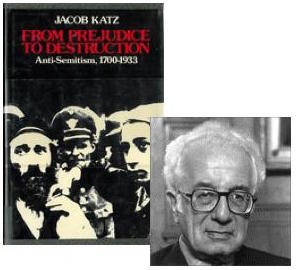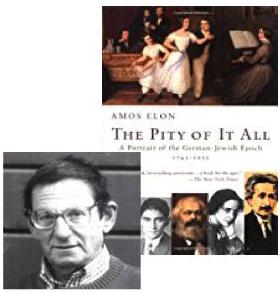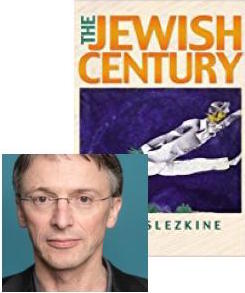 I have been reading (and re-reading) several books on the grisly history of anti-Semitism. A few weeks ago I posted on a couple of thoughts that arose out of my reading of From Prejudice to Destruction: Anti-Semitism, 1700-1933 (1980) by Jacob Katz. Katz covers the rise of anti-Semitism from the Age of Enlightenment through to the rise of Nazism. His survey covers not only Germany but also France and Austria-Hungary during that period.
I have been reading (and re-reading) several books on the grisly history of anti-Semitism. A few weeks ago I posted on a couple of thoughts that arose out of my reading of From Prejudice to Destruction: Anti-Semitism, 1700-1933 (1980) by Jacob Katz. Katz covers the rise of anti-Semitism from the Age of Enlightenment through to the rise of Nazism. His survey covers not only Germany but also France and Austria-Hungary during that period.
If hatred of Jews is a product of Christianity’s ancient and medieval heritage of blaming the Jews for the death of Jesus, why did anti-Semitism flourish despite the advent of the Enlightenment, rationalism, the ideals of brotherhood and equality that were fanned with the French Revolution and Napoleonic conquests? How do we explain the survival and eventual avalanching of ant-Semitism despite a time in history when Jews were finding themselves being successfully assimilated into society as professionals, intellectuals, and more?
Through Katz’s book it is clear that Hitler did not suddenly come upon the scene and manufacture a popular antagonism against Jews. Hitler merely exploited what was already fermenting before his arrival on the scene.
Katz’s answers are interesting. They are compatible, for most part, with the analyses of the other authors I read.
 Another work, one that covers a wider field than Katz’s primary focus on the history of written ideas, is The Pity of it All: A Portrait of the German-Jewish Epoch 1743-1933 (2002) by Amos Elon. Elon writes more colourful portraits of individuals, from Moses Mendelssohn to Albert Einstein. Elon takes us through the struggles of many high-achieving Jews to slough off their “Jewishness” in order to become one with other Germans both in professional status and cultural acceptance. Yet, the “pity of it all” was, of course, that the reader knows the outcome before the final chapter and that it was all in vain.
Another work, one that covers a wider field than Katz’s primary focus on the history of written ideas, is The Pity of it All: A Portrait of the German-Jewish Epoch 1743-1933 (2002) by Amos Elon. Elon writes more colourful portraits of individuals, from Moses Mendelssohn to Albert Einstein. Elon takes us through the struggles of many high-achieving Jews to slough off their “Jewishness” in order to become one with other Germans both in professional status and cultural acceptance. Yet, the “pity of it all” was, of course, that the reader knows the outcome before the final chapter and that it was all in vain.
Meanwhile, I found myself turning back to re-read Jewish History, Jewish Religion: The Weight of Three Thousand Years (2008 edition) by Israel Shahak. Shahak’s little volume is a sharp reminder of the unsavoury tribalism at the heart of beliefs and practices of many religiously conservative Jews and nationalist Israelis even today. So often a haloed religious smile hypocritically hides a judgmental, intolerant heart. Elements of the superstitions and ugly tribalism associated with medieval Jewish ghetto life that more cosmopolitan Jews since the Enlightenment have sought so diligently to escape are still with us, unfortunately.
 Finally there was The Jewish Century (2004), an award-winning book by Yuri Slezkine. Slezkine’s primary focus, unlike the above works, is on the Jewish experience in Russia and the contrasting experiences of Jewish emigres in, above all, the United States of America and Israel. His first few chapters were far too literary, metaphorical, for my taste that was seeking something more direct and prosaic. But I could not ignore his point and had absorbed his message by the final section.
Finally there was The Jewish Century (2004), an award-winning book by Yuri Slezkine. Slezkine’s primary focus, unlike the above works, is on the Jewish experience in Russia and the contrasting experiences of Jewish emigres in, above all, the United States of America and Israel. His first few chapters were far too literary, metaphorical, for my taste that was seeking something more direct and prosaic. But I could not ignore his point and had absorbed his message by the final section.
Once again we find ourselves immersed in the by now familiar story: Jews finding themselves, or rather making themselves, increasingly accepted in their host society only to find themselves suddenly once again fallen from grace despite their best and most loyal efforts. Tribal nationalism trumped the idealism of socialism in Russia. The same atavistic nationalism that animated the pre-war world survives as a regressive anachronism in Zionism.
Only Israel continued to live in the European 1930s; only Israel still belonged to the eternally young, worshiped athleticism and inarticulateness, celebrated combat and secret police, promoting hiking and scouting, despised doubt and introspection, embodied the seamless unity of the chosen, and rejected most traits traditionally associated with Jewishness. (p. 327)
How has it been allowed to flourish as such an anachronism? Whence the unquestioning support for the Zionist state of Israel from the world that fought to end the worst excesses of nationalism and racism?
The most fundamental way in which World War II transformed the world was that it gave birth to a new moral absolute: the Nazis as universal evil. . . .
It was only a matter of time, in other words, before the central targets of Nazi violence became the world’s universal victims. From being the Jewish God’s Chosen People, the Jews had become the Nazis’ chosen people, and by becoming the Nazis’ chosen people, they became the Chosen People of the postwar Western world. The Holocaust became the measure of all crimes, and anti-Semitism became the only irredeemable form of ethnic bigotry in Western public life (no other kind of national hostility, however chronic or violent, has a special term attached to it — unless one counts “racism,” which is comparable but not tribe-specific). (pp. 360-361, my bolding)
Continue reading “Still Chosen After All These Centuries: Readings on Modern Jewish Experiences”
